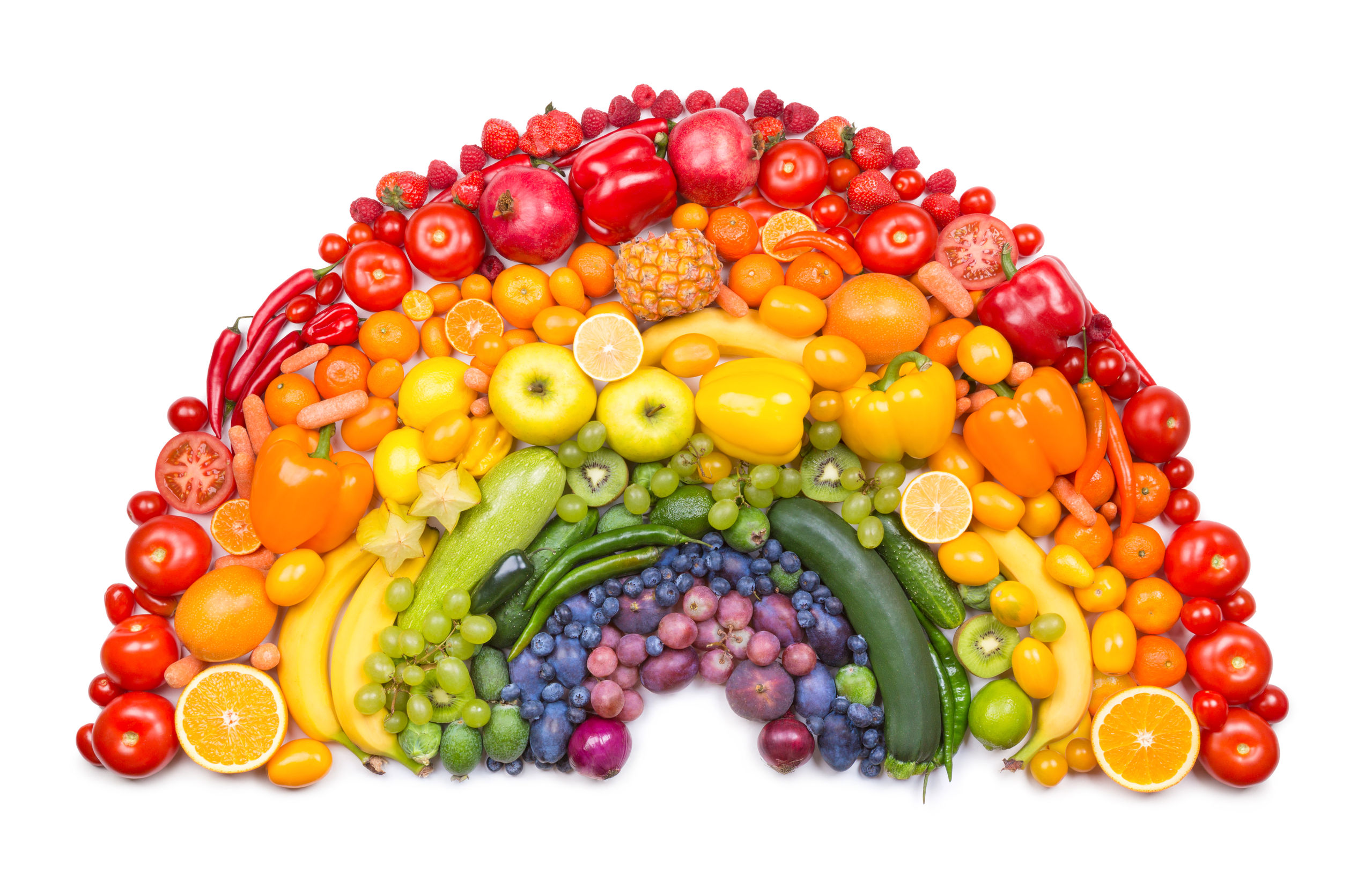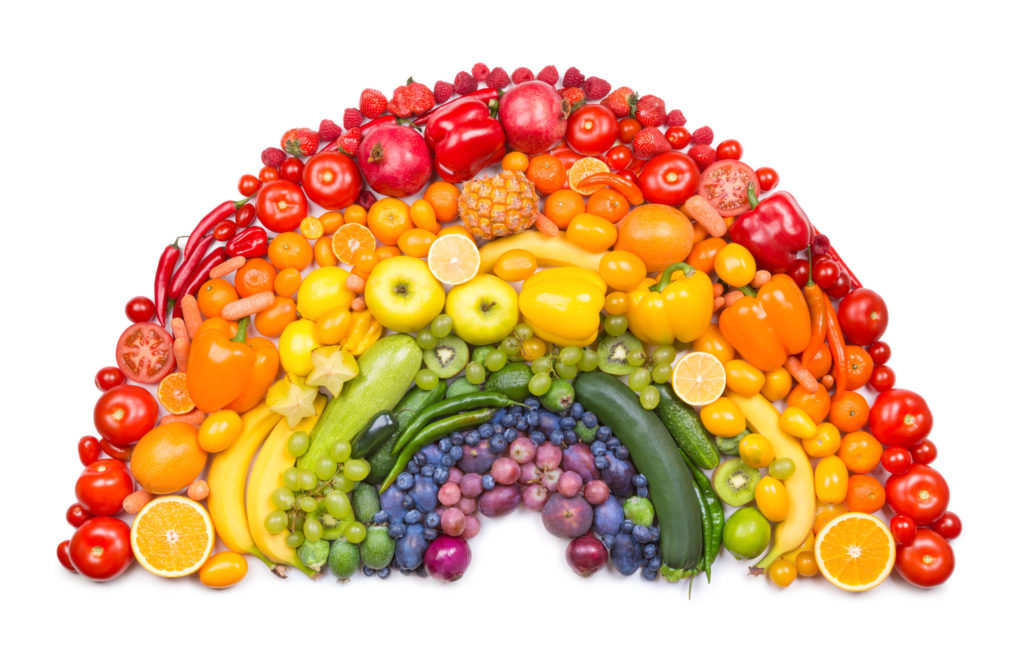
Many people teach that a “Plant Based” diet is the key to optimal health. I would argue that a “Colorful Diet” is even more important.
When my girls were little and first learning about their food we used to talk about eating a rainbow of colors every day.
I had this great book, “I Can Eat A Rainbow” by Annabel Karmel, that walked through each color of the rainbow, and in fun food-based animal images talked about the fruits & veggies that fit into each color group.
I even took this book to their preschool & kindergarten and gave little rainbow lessons to the children about how to choose healthy foods.
It was incredibly effective! My girls loved checking off their list of colors each day and would help me make decisions about what their snack or veggies at dinner would be based on what colors were left for the day.
We even made Rainbow Fruit Kabobs for birthday celebrations and gatherings.
It occurred to me that there’s no reason this method shouldn’t also work for grown-ups. Because the truth is we ALL need to be eating a rainbow of colors every day.
Plants are full of good-for-you fiber, vitamins, and minerals. But what’s even more exciting about plants are the chemicals in them that create pigment…or give the plant its color!
It is these chemicals that are being shown in research studies to reduce inflammation, kill cancer cells, and prevent diseases such as Diabetes, Heart Disease, Parkinson’s, Alzheimer’s, and more.
You can read more about Phytonutrients & Health here: (1, 2, 3, 4)
The Power of Color
These colorful plant chemicals are also known as phytonutrients and make up all the different nutrients in plants that don’t fall into the category of vitamin or mineral.
Plants produce these nutrients to protect themselves against environmental threats like pests, pollution, harsh growing conditions, or disease.
This is actually why organic fruits & veggies have been shown to have higher levels of phytonutrients in them. When a plant has to defend itself against pathogens (as is the case with organic food) this increases its production of chemicals to help fight off the disease or pest, which in turn increases its level of beneficial phytonutrients. (study)
And although most of us are familiar with the different vitamins and minerals we should be including in our diet, the same is not true for phytonutrients.
According to a 2009 phytonutrients report (from the National Health and Nutrition Examination Surveys), 8 out of 10 people in the US are falling short in virtually every color category of phytonutrients.
- 69% are falling short in green phytonutrients
- 78% are falling short in red phytonutrients
- 86% are falling short in white phytonutrients
- 88% are falling short in purple and blue phytonutrients
- 79% are falling short in yellow and orange phytonutrients
Is this true for you?!
With just a little awareness & intentional meal planning we can change that.
Let’s take a look at each of the six color groups, why they are important, which foods fall into each category, and ideas to help you get more of those colors in your diet every day.
Red Foods
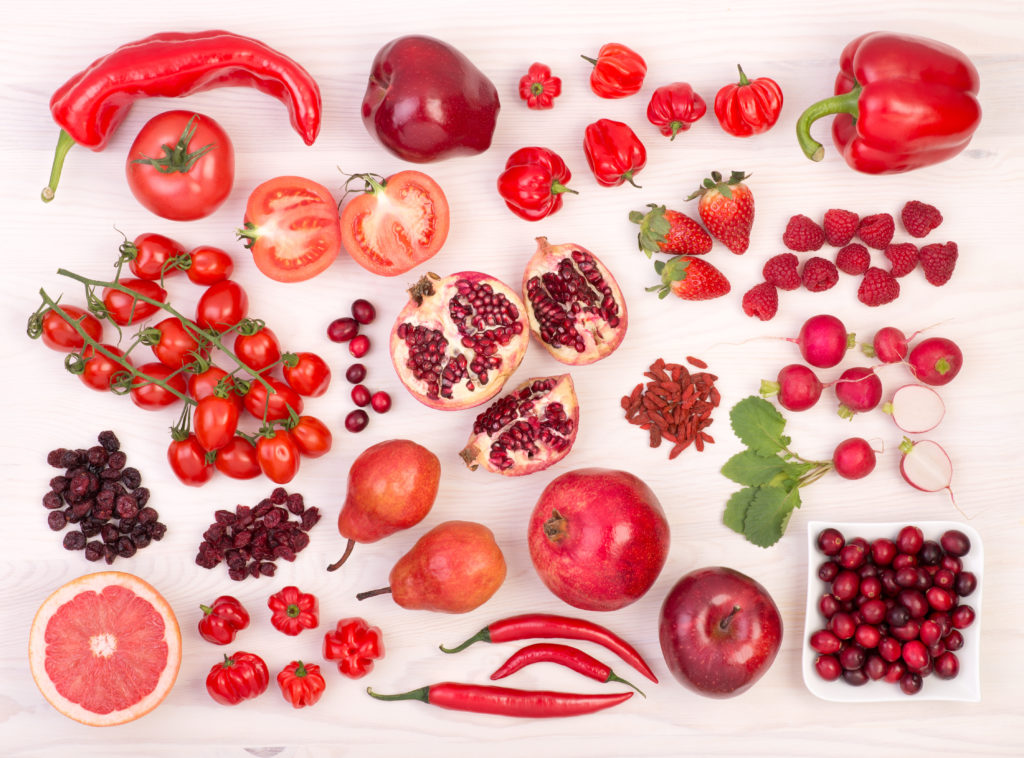
Foods rich in the color red are a great source of the following phytonutrients:
- Lycopene
- Ellagic Acid
- Quercitin
- Anthocyanins
The benefits of phytonutrients are widespread and improve markers for many different diseases; this is why including all of them in your diet is important regardless of what specific health concern or condition you’re trying to prevent or heal from.
In general, the phytonutrients listed above for red foods are protective against heart disease and cancer, especially prostate cancer. They are also good at boosting the immune system and lowering inflammation. As well as decreasing the risk for stroke and macular degeneration.
Fruits
strawberries, raspberries, cranberry, watermelon, guava, pink grapefruit, red apples, pomegranate, cherries, red grapes, raisins, goji berries
Veggies
tomatoes, red bell pepper, chili peppers, red beets, radishes, red onion, rhubarb
Other Foods
red spices (cayenne, paprika, chili powder, saffron, sumac), red kidney beans
How To Eat More
As always I encourage you to stick to the foods that are in season and locally available to you.
- Add red berries, cherries, or pomegranates to your smoothies, yogurt, or hot cereal.
- Use tomato based sauces in your cooking (cooked tomato dramatically increases the bioavailability of lycopene)
- Add red bell pepper, radishes, & beets to your salads.
- Have some sliced watermelon or guava for dessert
- Keep a bowl of red grapes out for a snack or for dessert
- Add some dried cranberries, cherries, or raisins to some raw nuts or seeds for a snack
- Add red kidney beans to a soup, salad, or chili
- Cook more with red spices
Orange Foods
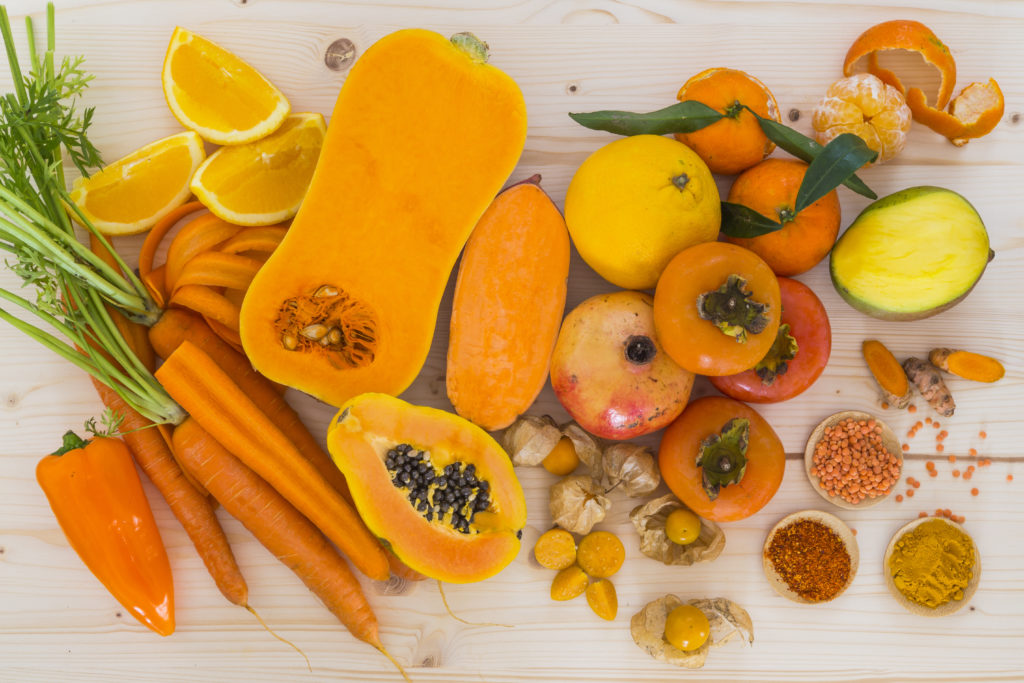
Foods rich in the color orange are a great source of the following phytonutrients:
- Beta-carotene
- Hesperidin
- Beta-cryptoxanthin
- Zeaxanthin
In general, the phytonutrients listed above for orange foods are great antioxidants and free radical scavengers. They protect against heart disease, lower inflammation, and support eye health. As well as reduce the risk for cancer, especially cancers of the lung, esophagus, and stomach.
Fruits
oranges, tangerines, persimmon, papaya, mango, cantaloupe, peaches, apricots, nectarines
Veggies
carrots, sweet potato, yams, pumpkin, butternut squash, acorn squash, orange bell pepper, orange beets
Other Foods
turmeric, orange lentils, orange citrus zest
How To Eat More
- Add orange fruits & fresh turmeric root to your smoothies
- Substitute sweet potatoes & yams in place of white potatoes
- Add some pumpkin or squash based soups to your meals
- Add orange bell pepper, carrots, & orange beets on top of your salads
- Any of the orange colored fruits would make an excellent dessert option
- Keep carrots & bell peppers on hand for an easy snack
- Cook more with turmeric
Yellow Foods

Foods rich in the color yellow are a great source of the following phytonutrients:
- Flavonoids
- Lutein
- Rutin
- Zeaxanthin
In general, the phytonutrients listed above for yellow foods are protective against tumor cell growth while also supporting detoxification. They lower inflammation and help to support the skin, eyes, brain, & heart.
Fruits
banana, pineapple, star fruit, asian pears, yellow apples, lemon, yellow watermelon
Veggies
yellow bell pepper, yellow carrots, corn, yellow beets, yellow squash, spaghetti squash, yellow potatoes, yellow tomatoes, yellow beans
Other Foods
ginger, lemon zest, cumin, mustard seeds
How To Eat More
- Cook more with ginger and add the fresh root to your smoothies.
- Make a hot tea with fresh ginger root.
- Add yellow tomatoes, bell pepper, carrot, & beets to your salad.
- Use spaghetti squash instead of noodles in pasta dishes.
- Toss pineapple into a fruit salad or serve on its own for a dessert.
- Add fresh corn to soups or salads.
- Use the whole lemon in fresh juice.
Green Foods
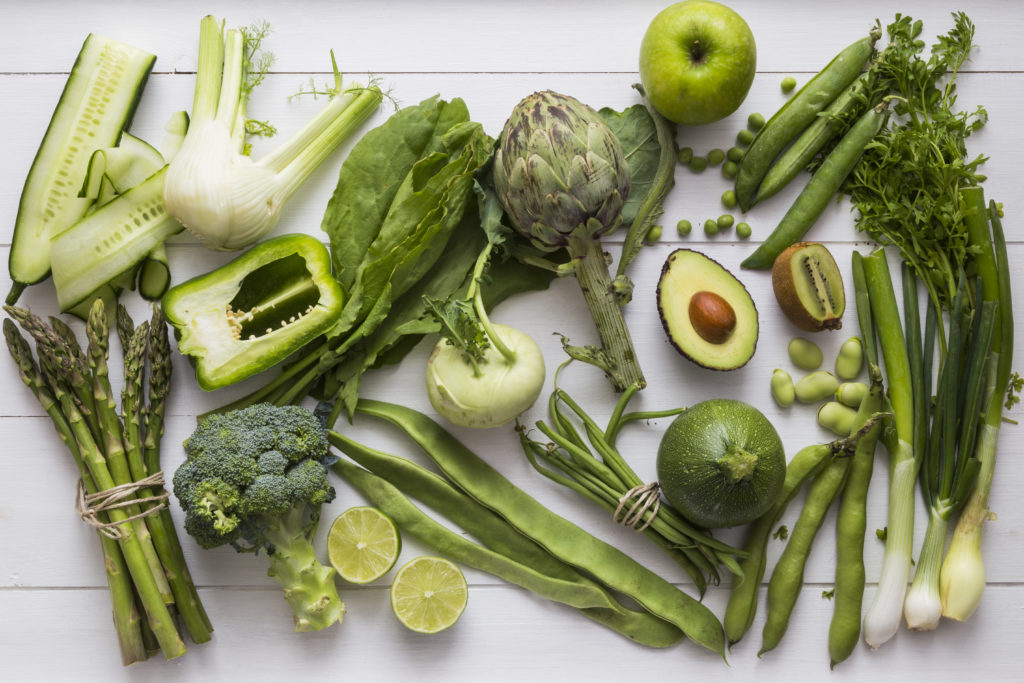
Foods rich in the color green are a great source of the following phytonutrients:
- Lutein
- Isothiocyanates
- Isoflavones
- Indoles
- Chlorophyll
- Carotenoids
- Catechins
In general, the phytonutrients listed above for green foods help to build healthy cells and genetic material. They support detoxification and help to eliminate extra estrogen and carcinogenic compounds. They also support eye health & boost the immune system.
Fruits
green apples, kiwi, green grapes, green melon, limes, pears
Veggies
broccoli, kale, cabbage, bok choy, lettuce, collard greens, Brussels sprouts, asparagus, spinach, swiss chard, arugula, green beans, peas, zucchini, artichokes, cucumber, green onions, celery, green bell pepper, watercress, okra, kohlrabi, fennel
Other Foods
avocado, edamame, pistachios, green olives, green tea, dried & fresh herbs
How To Eat More
- Add avocado to toast, sandwiches, or smoothies.
- Mix in at least 2 different green veggies into your salad plus a healthy green fat like pistachios, olives, or avocado.
- Add green tea to your rotation of beverages each day.
- Cook more with fresh & dried herbs.
- Add leafy greens to your smoothies & soups.
- Snack on pistachios, olives, or edamame.
- Try to include at least 1 green veggie (+ another color) at lunch & dinner.
Blue/Purple Foods

Foods rich in the colors blue & purple are a great source of the following phytonutrients:
- Anthocyanins
- Resveratrol
- Flavonoids
In general, the phytonutrients listed above for blue & purple foods are protective against heart disease and cancer, as well as improving memory. They work to repair damage from oxidative stress and inflammation. They help keep you young and help to prevent collagen destruction, which supports skin health.
Fruits
plums, figs, purple grapes, prunes, blueberries, blackberries, boysenberries, juniper berries, dates, black currants, elderberries
Veggies
purple cabbage, eggplant, purple carrots, purple potatoes, radicchio, purple bell pepper, purple artichoke
Other Foods
lavender, sumac, black beans, purple basil, black pepper, urfa (spice)
How To Eat More
- Add blue & black colored berries to your smoothies or on top of your yogurt or hot cereal.
- Roast purple carrots or purple potatoes for a side dish to your next meal.
- Add sliced or shredded purple cabbage & radicchio to your salad.
- Make fajitas with black beans & assorted colors of sauteed bell peppers.
- The next time you’re grilling add some eggplant & purple bell pepper to the grill.
White/Brown Foods
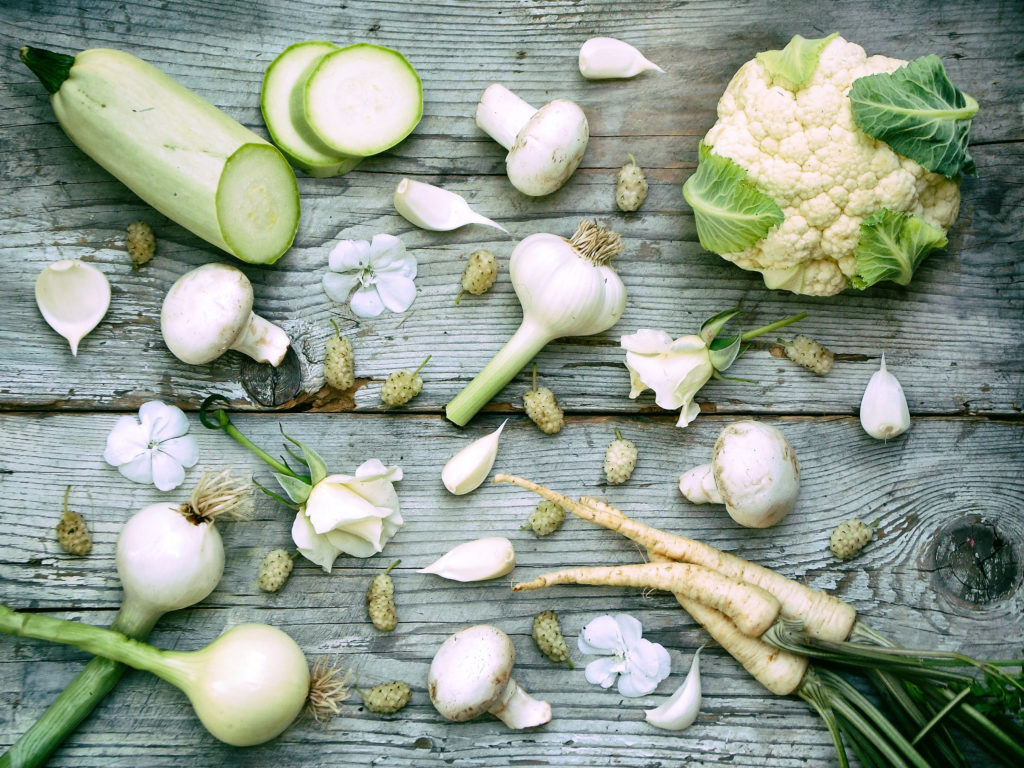
Foods rich in the colors white & brown are a great source of the following phytonutrients:
- Allyl Sulfides
- Indoles
- Quercitin
- Anthoxanthins
- Glucans (found in mushrooms)
In general, the phytonutrients listed above for white & brown foods are protective against cancers and inflammation. They can destroy cancer cells, reduce cell division, and support immune function. They also protect against heart disease and help to balance blood sugar.
Fruits
banana, white peaches, white nectarines
Veggies
mushrooms, cauliflower, onions, garlic, leeks, shallots, potatoes, parsnips, jicama, daikon radish, rutabaga, turnips, white carrots, white asparagus, jerusalem artichoke, white corn
Other Foods
brown colored spices (cinnamon, cloves, nutmeg, allspice, caraway, cardamom, cumin, coriander, anise), garbanzo beans, white beans, brown lentils
How To Eat More
- Always cook with onion, shallots, leeks, or garlic as part of your base.
- Add cinnamon to your hot cereal or yogurt.
- Cook with more brown colored spices.
- Add mushrooms to your stir-fry or throw on the grill for a yummy side dish.
- Roast a variety of white root veggies to add to meals or salads.
My Favorite Rainbow Recipes

It doesn’t have to be hard to get all your colors in each day. There are many yummy ways where you can get most, if not all, of your colors in just one meal. Here are some of my favorites.
A Checklist To Reach Your Goal
If digestion begins with your eyes, then make your plate as colorful as possible. Not only will this make your food more beautiful and appetizing, it will also improve digestion and your health!
The GOAL = 1+ foods from every color every day
This means at least 6 different colors plus 8-10 servings of fruits & veggies every day!
As with anything, it’s helpful to have a sense of what you’re currently doing.
Keep a journal for a few days and check off how many colors you’re typically getting.
- Is there at least 1 food in each color group every day?
- Are there some colors that you’re never getting?
Start with the ones you’re never, or rarely, getting. Refer to the examples above and start planning in ways you can eat more.
- Can you add it to the meals you’re already doing?
- Can you add it in as part of a snack or a dessert?
- Can you try one of the Rainbow Recipes above?
Then move on to the colors you are getting in but not consistently.
- Is there a way you could start bringing in that color every day?
- How could you do more?
With just a bit of awareness, you’ll be surprised how easy it is to check off all of your colors each day. Your grocery cart will become more colorful. Your table and plate will become more colorful. You will be adding more beauty and variety to your meals while gaining the benefits from immune boosting, inflammation lowering, disease preventing phytonutrients!
